火星 月惑星研究会 関西支部

Mars Image 2005/10/07(UT)
瀧本郁夫,柚木健吉,畑中明利,
Carlos.E.Hernandez,Ralf Vandebergh,Diego Barucco
I.Takimoto,K.Yunoki,A.Hatanaka,Carlos.E,R.Vandebergh,D.Barucco
解説(安達)
柚木氏の青画像では、前日よりもシルチス・マイナー(Syrtis Miner;260W,0)
付近が暗く見えている。また17:05(UT)の青画像には白斑が写っている。画像
からは、白雲であることははっきりしているが、発生した理由がよく分からな
い。日没に近付くに連れてしだいに明るくなる様子が記録されている。
(reported by 6 observers)
In a blue image of Yunoki, the vicinity of Syrtis Minor (260W,0) looks
darker than the day before. Moreover, to a blue image of 17:05(UT)
White spot is reflected. It is clear that it is white clouds from the
image. The reason why this cloud is generated is not understood well.
The appearance that lightens gradually while approaching at the sunset
is recorded. (reported by 6 observers)
FROM Makoto ADACHI
-------------------------------------------------------------------------------------
|
Ikuo Takimoto (310mm Newtonian :ToUcam Pro )
|
コメント:日本海から南下してくる前線の影響で不安定な天候となった。帰宅時には雲って
いたが、その後晴れ間がのぞき、撮像を開始した。
もう少し良いシーイングに恵まれると思ったが、雲が広がってしまった。
ノドス(NODUS)からシルチス(SYRTIS)に筋が繋がっているようにも見える。ヘラス(HELLAS)北部が目だって明るい。
ボレオシルチス(BOREOSYRTIS)付近の北極雲が青く見えた。
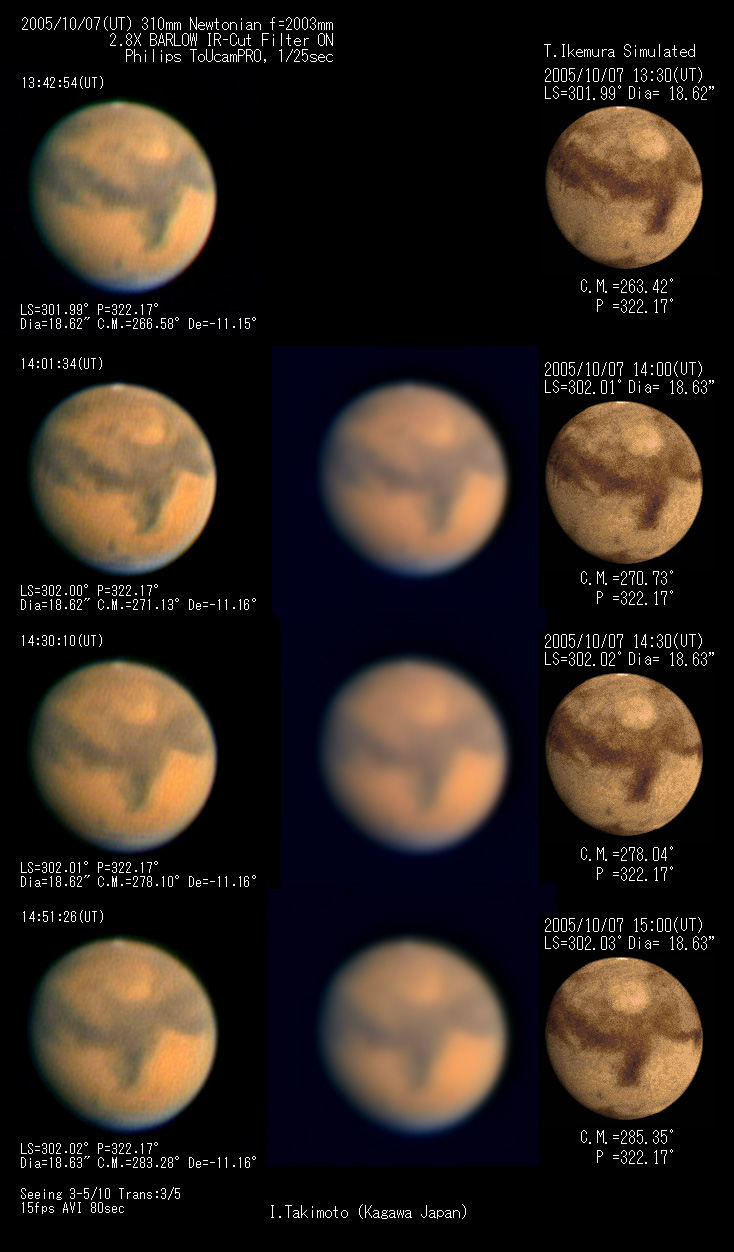 [Ayauta-gun Kagawa-Prefecture Japan]
≪香川県 綾歌郡 瀧本郁夫≫
[Ayauta-gun Kagawa-Prefecture Japan]
≪香川県 綾歌郡 瀧本郁夫≫
|
Kenkichi.Yunoki (200mm Newtonian, ToUcam Pro)
|
天気予報では曇りだったが、良く晴れて透明度も良かった。
衝のころシルティス メジャー付近で確認し易いといわれるBlue clearing は確認出来ません、というよりB2(450nm)でむしろシルティスが明るい。
16:40〜17:05(UT)のB画像でティレニウムとシルティス メジャーの付け根の接する辺りに白く小さな○の模様がありますが。これは雲なのでしょうか。
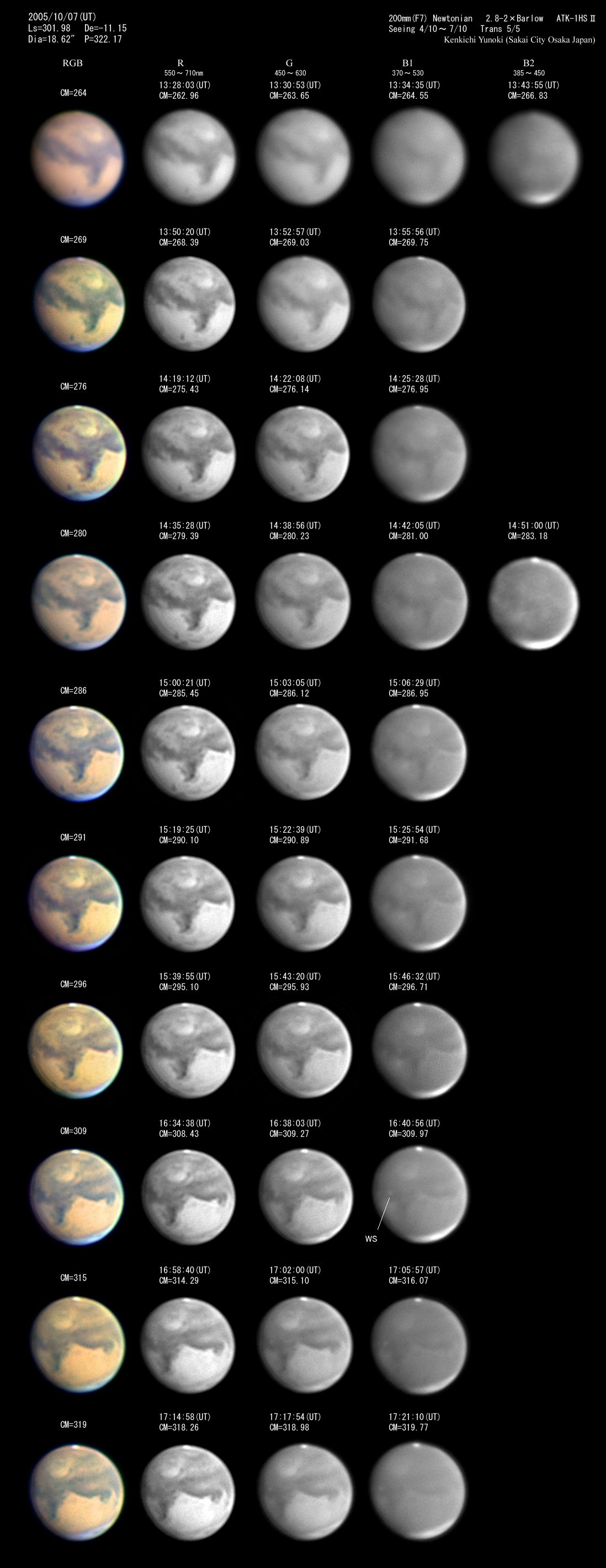
[Kenkichi Yunoki (Sakai City Japan)]
≪大阪府 堺市 柚木健吉≫
|
Akitoshi Hatanaka (400mm Cassegrain, ToUcam Pro)
|
40cm Cassegrain(F15) 1 degree Prisum IR block Filter
Philips ToUcam Pro Rezistax seeing 3-4/10 trans 5/10
雨が降っていたが、朝4時半頃、晴れていることに気づき、
撮影をはじめたが、IR像を取り始めたころから雲がかかりはじめ
すぐ曇ってしまった。
よくゆれていたが、模様のコントラストが良かった。
ヘラスは、依然として黄色いようだ。
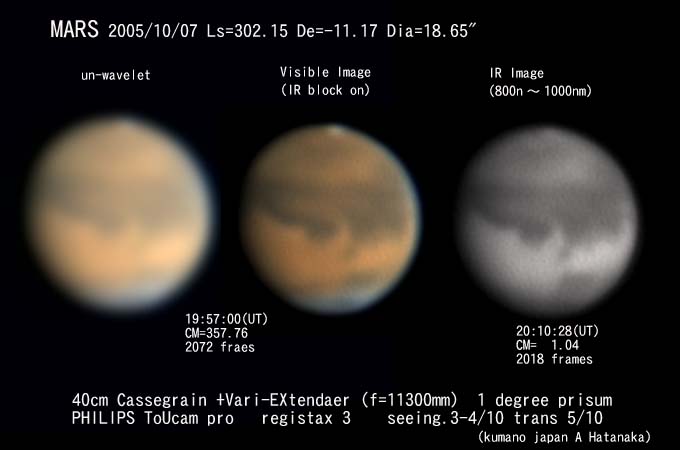 ≪三重県熊野市 畑中明利≫
≪三重県熊野市 畑中明利≫
|
Carlos E. Hernandez (Drawing:9-inch (23-cm) F/13.5 Maksutov- Cassegrain)
|
Date (U.T.): September 7, 2005
Time (U.T.): 04:20 (left image) and 05:30 (right image)
CM: 129.4 (left image) and 146.4 (right image)
Ls: 301.8 (Mid-Northern Winter/Southern Summer)
De -10.8, Ds -20.9, p 0.95, 18.6"
Instrument: 9" F/13.5 Maksutov-Cassegrain
Magnification: 248x and 344x
Filters (Wratten): 30 and 38
Seeing (1-10): 6-7, Antoniadi (I-V): II
Transparency (1-6): 3 (hazy)
Notes:
04:20 U.T. (Left image, IL/W30): The South Polar Cap (SPC) was very small and brilliant (10/10). Mare Australe appeared dark to dusky (3-4/10) and mottled. Bosporos Gemmatus, Aonius Sinus, and Palinuri Fretum appeared dark to dusky (3-4/10) and irregular over certain segments. Thaumasia, Daedalia, and Phaethontis appeared bright (7/10). Solis Lacus appeared dark to dusky (3-4/10) and elongated north-south towards the preceding limb. Dusky (4/10) projections were noted to extend from it's north-preceding border (Geryon) and southern border (Ambrosia and Bathys). A dusky (4/10) and partially obscured (haze) Tithonius Lacus was visible north of Solis Lacus. Thaumasia (northern portion) and Ophir appeared very bright (8/10, most likely due to water vapor/haze). Phasis appeared as thin, dark (3/10) finger-like projection (northward) from Aonius Sinus. Mare Sirenum was dark to dusky (3-4/10) following the CM and appeared to contain mottling within it, especially during moments of very steady seeing. Araxes (4-5/10) was visibly extending from the preceding tip of Mare Sirenum. A very bright (8/10) circular albedo feature was noted in the region of Phoenicis Lacus at the eastern (preceding) tip of Araxes (Lux?). The eastern (preceding) section of "Valhalla" was noted north of Mare Sirenum over Memnonia (7/10). The eastern (preceding) tip of Mare Cimmerium was visible (4/10) on the following limb. The following (western) border of Mare Acidalium was visible (5/10) along the preceding limb partially obscured by a very bright to extremely bright (8-9/10) evening limb haze (ELH, 9/10). An orographic (mountain-associated) cloud was visible over the region of Olympus Mons (especially noted using the Wratten 30 (magenta) filter). A small, thin and dusky (4/10) albedo feature was noted north of this cloud. I do not believe that I was observing the actual shadow of Olympus Mons (especially so close to the CM), but rather the shadow (?) of the orographic cloud instead. Tharsis and A
mazonis appeared shaded to bright (6-7/10) and mottled (especially Amazonis). A very bright to extremely bright (8-9/10) North Polar Hood (NPH) was visible (inconsistent in density as dusky (4/10) albedo features were visible through portions of it). An extremely bright (9/10) morning limb haze (MLH) was visible.
05:30 U.T. (Right image, W38): The South Polar Cap (SPC) appeared very small and brilliant (10/10). Extremely bright (9/10) morning limb haze (MLH), evening limb haze (ELH), and North Polar Hood (NPH) were visible. The eastern (preceding) section of Tharsis was very bright (8/10). Mare Sirenum (5/10) appeared to be bordered by bright to very bright (7-8/10) clouds/haze. The Olympus Mons orographic cloud appeared very bright (8/10) on the CM.
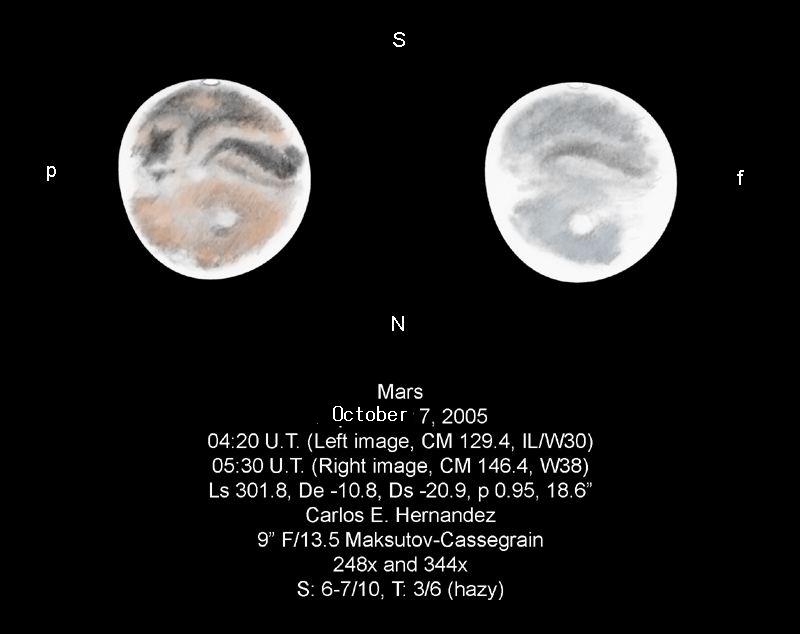
[[Carlos.E. Hernandez South Florida U.S.A ]]
|
Ralf Vandebergh(250mm Newton:ATK-1HS)
|
Another result from Oct 7. time: 02:34 UTC.Vallis Marineris is well visible in this image.
(10 inch Newton & ATK-1HS @ 0.08´´/p f/60 R-sG-B)
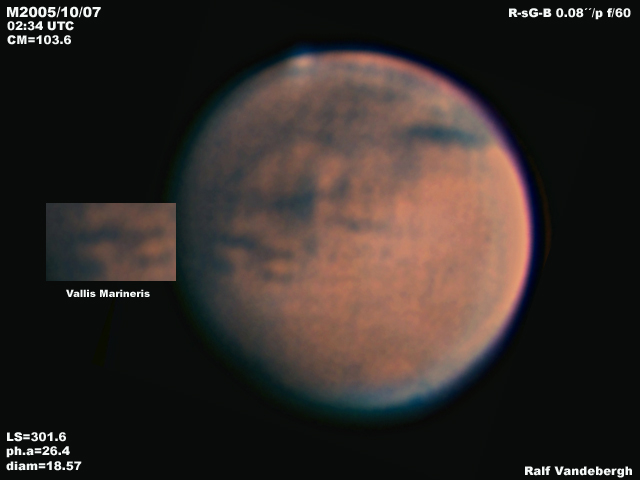 Attached are my first new observations since the good late September period 20-22.The first obvious thing
when I brought Mars on screen was the size which was grown considerable,second thing and this in the blue
light was the visibility of the Arsia orographic cloud which was impressing large,already during live capturing
for the eye visible on the monitor screen.For this session I used real red,no IR as usuall.The seeing was very
good to exellent while I captured to a thin layer of mist or low clouds.The red images now looked really better
then those in near-infrared concerning resolution.
Added to the RGB full disk image(with nicely visible some small projections inMare Sirenum/Memnonia)
is a HC blue light image and a partial high contrast RGB color image of the
Tharsir region with the orographic clouds in color.
Attached are my first new observations since the good late September period 20-22.The first obvious thing
when I brought Mars on screen was the size which was grown considerable,second thing and this in the blue
light was the visibility of the Arsia orographic cloud which was impressing large,already during live capturing
for the eye visible on the monitor screen.For this session I used real red,no IR as usuall.The seeing was very
good to exellent while I captured to a thin layer of mist or low clouds.The red images now looked really better
then those in near-infrared concerning resolution.
Added to the RGB full disk image(with nicely visible some small projections inMare Sirenum/Memnonia)
is a HC blue light image and a partial high contrast RGB color image of the
Tharsir region with the orographic clouds in color.
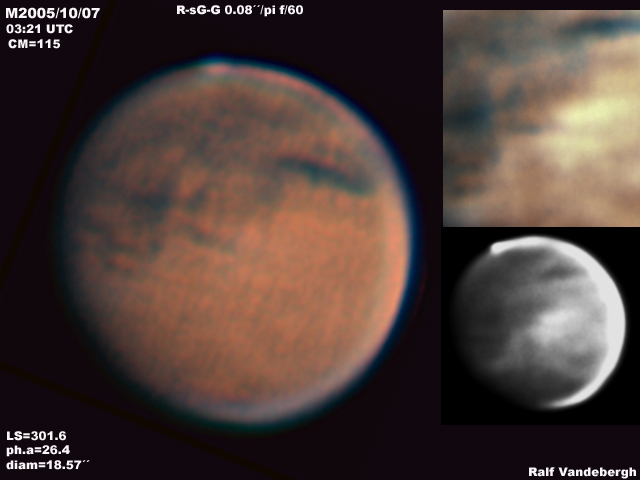 This image taken Oct 7, 03:01 UTC shows very fine detail across the whole image.
The flake-shaped structures across the Tharsis-Tractus Albus area is not noise but
a real network of fine detail.Note a very small canal-structure betweenPhoenicis Lacus
and Tithonius Lacus.Also several other fine structures in this region can be seen.
(10 inch Newton & ATK-1HS @ 0.08´´/p f/60 R-sG-B).
This image taken Oct 7, 03:01 UTC shows very fine detail across the whole image.
The flake-shaped structures across the Tharsis-Tractus Albus area is not noise but
a real network of fine detail.Note a very small canal-structure betweenPhoenicis Lacus
and Tithonius Lacus.Also several other fine structures in this region can be seen.
(10 inch Newton & ATK-1HS @ 0.08´´/p f/60 R-sG-B).
 [バンディバ:オランダ]
[Ralf Vandebergh:Neighbourhood of Maastricht Netherlands]
[バンディバ:オランダ]
[Ralf Vandebergh:Neighbourhood of Maastricht Netherlands]
|
Diego Barucco(250mm newtonian:ES640 Astromeccanica)
|
2005/10/07 23:54(UT)
250mm newtonian ES640 astromeccanica
seeing 5 /10; trasp . 9 /10
 [Diego Barucco:Siracusa Italy]
[Diego Barucco:Siracusa Italy]


[Ayauta-gun Kagawa-Prefecture Japan] ≪香川県 綾歌郡 瀧本郁夫≫

≪三重県熊野市 畑中明利≫

Attached are my first new observations since the good late September period 20-22.The first obvious thing when I brought Mars on screen was the size which was grown considerable,second thing and this in the blue light was the visibility of the Arsia orographic cloud which was impressing large,already during live capturing for the eye visible on the monitor screen.For this session I used real red,no IR as usuall.The seeing was very good to exellent while I captured to a thin layer of mist or low clouds.The red images now looked really better then those in near-infrared concerning resolution. Added to the RGB full disk image(with nicely visible some small projections inMare Sirenum/Memnonia) is a HC blue light image and a partial high contrast RGB color image of the Tharsir region with the orographic clouds in color.
This image taken Oct 7, 03:01 UTC shows very fine detail across the whole image. The flake-shaped structures across the Tharsis-Tractus Albus area is not noise but a real network of fine detail.Note a very small canal-structure betweenPhoenicis Lacus and Tithonius Lacus.Also several other fine structures in this region can be seen. (10 inch Newton & ATK-1HS @ 0.08´´/p f/60 R-sG-B).
[バンディバ:オランダ] [Ralf Vandebergh:Neighbourhood of Maastricht Netherlands]
[Diego Barucco:Siracusa Italy]
 ALPO-Japan Latest
ALPO-Japan Latest

 Mars Section
Mars Section